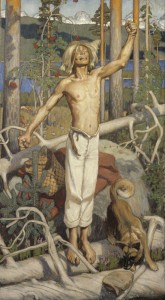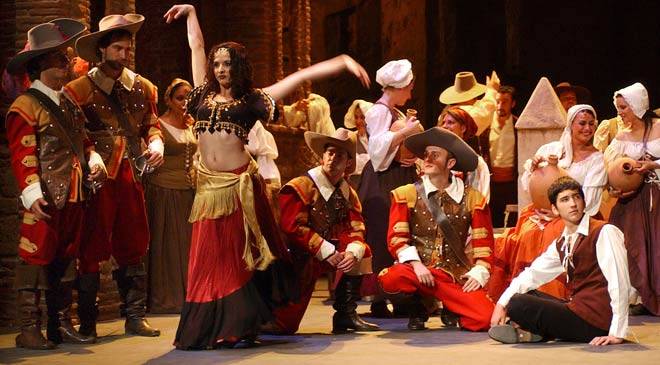Spain and Catalonia have always stood apart from the mainstream of European culture, doing things after their own fashion. Among these distinctions was their fondness, over several centuries, for zarzuela, an alternative to Opera, with its own styles and conventions. While zarzuelas were staged as early as the mid-seventeenth century, they reached their apogee of popularity and artistic glory in the early 20th century, and were still going strong decades after opera had ceased to be broadly popular. There are distinctive styles of zarzuela sung in Catalan (sarsuela) and in Basque (zartzuelak). The romanzas of this kind of music-drama are the equivalent of opera’s arias.
Category Archives: CN - Listening 2008 - Page 5
First-time listening for April, 2008
18441. (Jim Carroll) Praying Mantis
18442. (Perth County Conspiracy) Does Not Exist
18443. (Paul Joseph Lorieau & Edmonton Fans) “Oh Canada”
18444. (Paul Segarini) Edison Twins Theme
18445. (Michael Mitchell) “Canada Is…”
18446. (Blood, Sweat & Tears) “Spinning Wheel”
Read more »
Sibelius’ Kullervo, Op.7
Kullervo is the darkest character in the Kalevala, the epic of Finnish mythology that had a profound effect on me in childhood. His story is told in runos 31 through 36 of the epic. Enslaved and abused as a child, Kullervo’s life is dominated by the quest for revenge, which leads him to commit horrifying crimes, including the rape of his own sister. The most striking part of the story is his death, where he asks his sword if he should kill himself, and the sword bursts into song:
 “Mieks’en söisi mielelläni,
“Mieks’en söisi mielelläni,
söisi syylistä lihoa,
viallista verta joisi?
Syön lihoa syyttömänki,
juon verta viattomanki.”
“Why, if I desire it,
should I not kill you,
swallow up your wicked blood?
I have consumed innocent flesh,
and swallowed up guiltless blood.”
This little sequence was borrowed by Poul Anderson in The Broken Sword, and by Michael Moorcock in one of his Elric tales. Väinämöinen, the wise central character of the Kalevala, remarks that Kullervo’s fate proves that children should never be mistreated, since an abused child will grow up without wisdom or honour. Read more »
Jake and the Fundamentals
Jake Thomas (“Jake the Snake”) and the Fundamentals have been the dean of the local R & B scene in North Bay, Ontario. I have a tape, The Fundamentals Live at the Dive, from a performance I attended and enjoyed. But the band line-up does not correspond to the current version of the band. It has a fine rendition of “Summer in the City” and also of one my favourite John Hyatt songs “Where is the Next One Coming From?”
Jimmy Cliff: Many Rivers To Cross
 My old friend Peter Svilans gave me a cd collection of Jimmy Cliff. Cliff was my first taste of Reggae. His appearance in the 1972 Jamaican film The Harder They Come, still sticks in my mind. I saw it at a rep-house showing in Petaluma, California, with my friend Simon Agree. Cliff played the lead character, and some of his best songs were played on the soundtrack: “You Can Get It If You Really Want”, “Many Rivers To Cross”, “The Harder They Come”, “Sitting Here In Limbo”. The first two of those are in the Trojan CD collection, and twenty-three other songs of uniformly high quality. Jimmy Cliff was eventually eclipsed in the public mind by Bob Marley, and that man’s genius is undeniable. But Jimmy’s music had a jaunty, innocent charm to it, and he should not be neglected in anyone’s collection. In his day, Reggae was still Island music, a down-home kind of thing. Marley made it cosmopolitan, universal. But Cliff, too, sometimes touched universal chords. Who is there, who has ever had to trudge through the weary ups and downs of life, who won’t respond to “Many Rivers to Cross”, the kind of song best heard late at night, stranded in a donut shop on a highway you never planned to drive.
My old friend Peter Svilans gave me a cd collection of Jimmy Cliff. Cliff was my first taste of Reggae. His appearance in the 1972 Jamaican film The Harder They Come, still sticks in my mind. I saw it at a rep-house showing in Petaluma, California, with my friend Simon Agree. Cliff played the lead character, and some of his best songs were played on the soundtrack: “You Can Get It If You Really Want”, “Many Rivers To Cross”, “The Harder They Come”, “Sitting Here In Limbo”. The first two of those are in the Trojan CD collection, and twenty-three other songs of uniformly high quality. Jimmy Cliff was eventually eclipsed in the public mind by Bob Marley, and that man’s genius is undeniable. But Jimmy’s music had a jaunty, innocent charm to it, and he should not be neglected in anyone’s collection. In his day, Reggae was still Island music, a down-home kind of thing. Marley made it cosmopolitan, universal. But Cliff, too, sometimes touched universal chords. Who is there, who has ever had to trudge through the weary ups and downs of life, who won’t respond to “Many Rivers to Cross”, the kind of song best heard late at night, stranded in a donut shop on a highway you never planned to drive.
Zhao Li
I haven’t been able to find out anything biographical about Zhao Li, composer of at least five film soundtracks — not even a birth date. I’ve been listening to the soundtrack of Xiǎochéng zhī chūn [Springtime in a Small Town], an acclaimed 2002 film by Tian Zhuangzhuang. The songs are a bit sugary, rather like Burt Bacharach, and not to my taste, but I like the orchestral interludes.
First-time listening for March, 2008
Carnival in Brazil: 40 Latin Classics:
. . . . 18306. (Brazilia Party Squad) “Brazil La La La La”
. . . . 18307. (Samba De Janeiro) “Samba De Janeiro”
. . . . 18308. (Maria Lopez) “Garota de Ipanema [The Girl from Ipanema]”
. . . . 18309. (João Fernandes) “Mais Que Nada”
. . . . 18310. (Del Paz) “Soul Bossa Nova [from Austin Powers]”
. . . . 18311. (Astrud De Mata) “Sway”
. . . . 18312. (Luis Alves) “Copacabana”
. . . . 18313. (Samba) “Lambada”
. . . . 18314. (Enrique Paz) “La Vida Es Un Carnival”
Read more »
Navajo Two-Step Songs Live
There’s nothing ponderously “spiritual” in Navaho Two-Step songs. This is party music, light-hearted and ironic songs of love and courting that you can hear at weekend social gatherings all over Dinetah. The genre has made stars of singers like Ed Lee Natay and Davis Mitchell. Navaho music is a bit far from my current stomping grounds, but years ago, I used to hang out in that part of the world, and I picked up some good tapes. This is one of my favourites, recorded at the Chinle Valley Festival in April of 1986. Fine performances by the Toh-Den-Nas Shai Singers, Twin Lakes Swingers, Smoke Signal Travelers, Four Corners Singers, Nataani Nez Travelers, Beclabito Valley Singers, and the Chinle Valley Boys. Most noteworthy are the bouncy first number, “Six Pack To Go” by Toh-Den-Nas Shai and the amusing “My Mother Dislikes Our Relationship” by Four Corners Singers.
Garcia Brothers, San Juan Pueblo
If you’re accustomed to the jaunty rhythms and vocal stylings at Canadian pow-wows, then the music from the New Mexico pueblos will seem a bit languid and monotonous to you. But the Garcia Brothers were good musicians, and their Green Corn Dance is quite appealing.
Jean Leloup
 I’m listening again, with pleasure, to L’amour est sans pitié, a 1990 album by the interesting Canadian rocker Jean Leloup. Leloup (“The Wolf”) is a stage name for Jean LeClerc, who was born in Quebec, but spent his childhood in Togo and Algeria, returning home at age fifteen. After an apprenticeship in the Quebec rock scene, he briefly found some national and international success with this album, which has songs in both French and English. He combined rock with rai elements long before anyone else was doing this in North America, and his lyrics are clever. I’m told that a subsequent album, Le Dôme, which was not as widely distributed, is even better. I haven’t found a copy yet. I understand that he subsequently published a philosophical novel called Noir destin que le mien, which I haven’t seen.
I’m listening again, with pleasure, to L’amour est sans pitié, a 1990 album by the interesting Canadian rocker Jean Leloup. Leloup (“The Wolf”) is a stage name for Jean LeClerc, who was born in Quebec, but spent his childhood in Togo and Algeria, returning home at age fifteen. After an apprenticeship in the Quebec rock scene, he briefly found some national and international success with this album, which has songs in both French and English. He combined rock with rai elements long before anyone else was doing this in North America, and his lyrics are clever. I’m told that a subsequent album, Le Dôme, which was not as widely distributed, is even better. I haven’t found a copy yet. I understand that he subsequently published a philosophical novel called Noir destin que le mien, which I haven’t seen.
